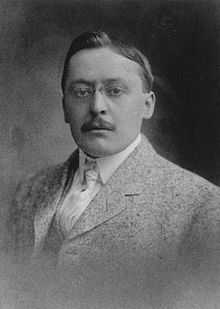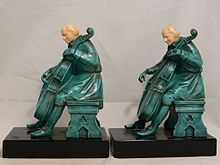John Ruhl (sculptor)
John Ruhl was an American sculptor of German descent born April 14, 1873 in New York City and died November 19, 1940 in Hackensack, New Jersey.

At an early age John knew exactly what he wanted to be when he grew up. He wanted to be an artist. His parents, Anton and Frieda, did everything they could to discourage him. They felt that all artists starved in attics. When he left the New York public school system, his father made him take a job with an insurance company as a clerk. He hated the work and longed for a career in the art field.
In 1888 he enrolled in the Metropolitan Museum of Art School. In April the following year, the Art School sponsored a contest for the students. Unbeknown to his parents, John entered the contest. On Saturday, April 28, The New York Sun reported, "The main prize of one hundred dollars was the Robert Hoe prize, offered in open competition for ‘an object of art.' The prize ‘For a Yacht Race' was won by John Ruhl whose design was a large vase shaped cup, done in plaster, it bore in bas relief on the body images of yachts in full sail and the handle was a dolphin." His parents were very impressed. At the age of 16 he earned probably more than his father made in a month in his shoe store. As a result his parents decided that maybe they had better leave him alone. So John left his insurance company job and went to study for about three years with a prominent sculptor Frank Edwin Elwell.
Career
John worked at the Piccirilli Brothers Studios for most or all of the time between 1905 and 1920 and possibly other years beyond that. There were many projects that the studios undertook during those years, but there are two that we know to have been done by the Piccirilli Studios that John was definitely involved with. The first were the marble lions in front of the New York Public Library at 5th Avenue and 42nd Street. The second is the Lincoln Memorial in Washington, D.C. It's likely that John got involved in many other projects at the studio over the years but these are the only two that we can definitely be sure of.
Collectors of antique bookends are familiar with his work. John's involvement in creating bookends began in 1915 and continued until his death in 1940, a period of about 25 years. Most of his work was for J.B.

Hirsch and Armor Bronze. Some work was also done for K&O (Kronheim and Oldenbusch). The Encyclopedia of Bookends by Louis Kuritzky has quite a few of his signed bookends including Dante Standing, Washington Bust, Man Reading, Deep in Thought, Cellist, and other unsigned done for J.B. Hirsch; Potter, Jester Lion Indian Scout, Searching Indian, Echo done for Armor Bronze; Washington Crossing the Delaware, Pirate with Sword and Musket, Roman and Scroll for K&O.
Attended The Beaux-Arts Institute of Design (BAID)
Sculpted the Indian head, Chief Obbatinewat, floor seal in the Shawmut Bank of Boston.
From The New York Sun, April 18, 1894 "David Dudley Field Death Mask" done by John Ruhl. David Dudley Field an American lawyer
We don't know exact dates, but we do know that John was still a pupil of Mr. Elwell in 1894 and that he was with him at least three years. Family records indicate that John helped set up two memorials, the Edwin Booth bronze bas relief at Mount Auburn Cemetery in Cambridge, Massachusetts and the General Winfield Scott Hancock bronze equestrian statue at Gettysburg, Pennsylvania. It's likely he accompanied Mr. Elwell out of town on both these occasions. The Booth Memorial was completed in 1894 and the Hancock Memorial in 1896. It's possible that John continued his studies at the Metropolitan Museum until the closing of their school in 1894 and then went to study under Elwell. His three years would then span 1894-97. The records do not exist any longer that would settle this question.
For some reason, April 1894 was a very important month for John. Two days before the death mask was made by John The New York Times of April 13 reported that the 16th annual exhibition of the Society of American Artists was closing its doors. The exhibition had opened to the public on March 12. The exhibitions of painting and sculpture were available for purchase. Not surprisingly, there were a lot more paintings than sculpture which consisted of "a baker's dozen" of small pieces including one by the famous sculptor Augustus Saint-Gaudens.
In this exhibition, both John and Mr. Elwell had pieces they made for sale. The New York Times reported: Diana of the Spear by Edwin F Elwell is a plaster statuette whose intention is better than its realization. The nude Diana is an ungraceful and perhaps impossible attitude with her legs apart and her weight on the right toes, while she is in the act of brandishing rather than hurling a spear. The modeling of the right breast and the right arm drawn back in the act of hurling is as questionable as the position of feet and legs. Though Diana was a goddess we have no right to assume that she could or would take such a pose when driving the spear at her antlered prey in the Forest of Arcady
On the other hand the article was more praiseworthy of John: There is a good plaster bust of young Mr. Bureau of Philadelphia by John Ruhl.
Exhibition catalogs exist for the various annual exhibitions of the Society of American Artists. A copy of the catalog for the 1894 exhibit exists at the Thomas Watson Library of the Metropolitan Museum of Art. Altogether there were 317 exhibits, and almost that many artists, only 13 of them were in sculpture, and they were all located in the Central Gallery. John was exhibitor #315 with his "Portrait of Mr. B." Exhibitor #316 and #306 was Alexander Sterling Calder senior, father of the artist made famous by his mobiles. Number 311 was a sculpture by the famous Augustus Saint Gaudens. John's teacher Mr. Elwell was #307 and he exhibited a sculpture called "Diana of the Spear." John was only 21 years old but his work must have been held in very high regard even at such an early date for him to have exhibited next to such illustrious people.
The 1939 GM Futurama Exhibit at the New York World's Fair "Building the World of Tomorrow" turned out to be the last project he worked on. John's job was to join the hundreds of other skilled artists and make many of the scale models in the exhibit. The work he did was while he was in the employ of George Wittbold, the builder
Awards
In 1913 John was listed in Who's Who in American Art. The qualifications listed under him included "Pupil of the Metropolitan Museum Art School under John Ward Stimson and Francis Edwin Elwell." Years later he was also listed in Who Was Who in American Art 1564-1975, a three-volume book by Falk, Peter Hastings (Editor).
John won several Society of Beaux-Arts Architects medals: 1st place for sculpture in 1913-14, two second places for sculpture in 1915-16, and two first places for sculpture in 1916-17.
In January 1915 he was awarded the first prize of $76 ($1,604 current buying power) in the Mrs. Henry Payne Whitney (Gertrude Vanderbilt Whitney) competition for students with a sculpture entitled "Youth." It shows a slender-limbed nude youth reaching out his toe to frighten a frog.
Sources
Ask Art: Ask Art: http://www.antiqueweek.com/ArchiveArticle.asp?newsid=647
Article in Antique Week: http://www.antiqueweek.com/ArchiveArticle.asp?newsid=647
Larkin, Susan Top Cats: The Life and Times of the New York Public Library Lions San Francisco, Pomegranate 2006
Cocchiarell, Marta, et al. Freeing the Angel from the Stone: The Contribution of the Piccirilli Brothers to Sculpture 1890 to the Present. New York, Italian American Museum, 2005
McBride, Gerald Collectors Guide to Cast Metal Bookends. Atglen, Pa. Schiffer
Kuritzky, Louis and Charles De Costa Collectors Encyclopedia of Bookends: Identity & Values. Collector Books
Futurama General Motors Corporation 1940
Society of Beaux-Arts Architects. Year Book of the Society of Beaux-Arts Architects and of the Beaux Arts Institute of Design 1914
Beaux Arts Studio. Society of Beaux Arts Architects Year Book of the Architectural League of New York 1914
Society of Beaux Arts Architects and National Sculpture. Thirtieth Annual Exhibition 1915
Society of Beaux Arts Architects and National Sculpture. Index of Exhibits Thirty-First Annual Exhibition 1916
Falk Peter Hastings Editor in Chief. Who Was Who in American Art 1564-1975 Madison Conn, Sound View Press 2001 c1999
Society of American Artists. Annual Exhibition Vol 16 (1894) New York
"Prize Winning Art Works Shown in Mrs. Henry Payne Whitney's Studio" New York Herald 17 January 1915:2 http://query.nytimes.com/mem/archive-free/pdf?res=F5071EFC3D5415738DDDAA0994DC405B8485F0D3
Working and Due Book Philadelphia Operative Plasterers Union, Local No 8 Philadelphia 1931
Working and Due Book Operative Plasterers and Cement Finishers International Association, Local 96 Washington D.C. 1922
Funeral of David Dudley Field" New York Times, 15 April 1894
"Prizes of the Art Schools" The Sun, 28 April 1889
Mrs. H.P. Whitney Prizes Awarded" New York Press, 17 January 1915